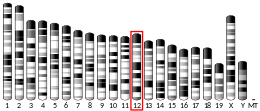Bradykinin receptor B1
Bradykinin receptor B1 (B1) is a G-protein coupled receptor encoded by the BDKRB1 gene in humans. Its principal ligand is bradykinin, a 9 amino acid peptide generated in pathophysiologic conditions such as inflammation, trauma, burns, shock, and allergy. The B1 receptor is one of two of G protein-coupled receptors that have been found which bind bradykinin and mediate responses to these pathophysiologic conditions.
B1 protein is synthesized de novo following tissue injury and receptor binding leads to an increase in the cytosolic calcium ion concentration, ultimately resulting in chronic and acute inflammatory responses.[5]
Classical agonist of this receptor includes bradykinin1-8 (bradykinin with the first 8 amino acid) and antagonist includes [Leu8]-bradykinin1-8.[6]
Antagonists
See also
References
- GRCh38: Ensembl release 89: ENSG00000100739 - Ensembl, May 2017
- GRCm38: Ensembl release 89: ENSMUSG00000041347 - Ensembl, May 2017
- "Human PubMed Reference:". National Center for Biotechnology Information, U.S. National Library of Medicine.
- "Mouse PubMed Reference:". National Center for Biotechnology Information, U.S. National Library of Medicine.
- "Entrez Gene: BDKRB1 bradykinin receptor B1".
- Seabrook GR, Bowery BJ, Hill RG. "Bradykinin receptors in mouse and rat isolated superior cervical ganglia". Br J Pharmacol. 115: 368–72. doi:10.1111/j.1476-5381.1995.tb15887.x. PMC 1908315. PMID 7670739.
External links
- "Bradykinin Receptors: B1". IUPHAR Database of Receptors and Ion Channels. International Union of Basic and Clinical Pharmacology.
- Human BDKRB1 genome location and BDKRB1 gene details page in the UCSC Genome Browser.
- Human BDKRB2 genome location and BDKRB2 gene details page in the UCSC Genome Browser.
Further reading
- Duchene J, Lecomte F, Ahmed S, Cayla C, Pesquero J, Bader M, Perretti M, Ahluwalia A (2007). "A novel inflammatory pathway involved in leukocyte recruitment: role for the kinin B1 receptor and the chemokine CXCL5". J. Immunol. 179 (7): 4849–56. doi:10.4049/jimmunol.179.7.4849. PMC 3696729. PMID 17878384.
- Calixto JB, Medeiros R, Fernandes ES, et al. (2005). "Kinin B1 receptors: key G-protein-coupled receptors and their role in inflammatory and painful processes". Br. J. Pharmacol. 143 (7): 803–18. doi:10.1038/sj.bjp.0706012. PMC 1575942. PMID 15520046.
- Menke JG, Borkowski JA, Bierilo KK, et al. (1994). "Expression cloning of a human B1 bradykinin receptor". J. Biol. Chem. 269 (34): 21583–6. PMID 8063797.
- Yang X, Polgar P (1996). "Genomic structure of the human bradykinin B1 receptor gene and preliminary characterization of its regulatory regions". Biochem. Biophys. Res. Commun. 222 (3): 718–25. doi:10.1006/bbrc.1996.0810. PMID 8651911.
- Bachvarov DR, Hess JF, Menke JG, et al. (1996). "Structure and genomic organization of the human B1 receptor gene for kinins (BDKRB1)". Genomics. 33 (3): 374–81. doi:10.1006/geno.1996.0213. PMID 8660997.
- Chai KX, Ni A, Wang D, et al. (1996). "Genomic DNA sequence, expression, and chromosomal localization of the human B1 bradykinin receptor gene BDKRB1". Genomics. 31 (1): 51–7. doi:10.1006/geno.1996.0008. PMID 8808279.
- Leeb T, Mathis SA, Leeb-Lundberg LM (1997). "The sixth transmembrane domains of the human B1 and B2 bradykinin receptors are structurally compatible and involved in discriminating between subtype-selective agonists". J. Biol. Chem. 272 (1): 311–7. doi:10.1074/jbc.272.1.311. PMID 8995263.
- Blaukat A, Herzer K, Schroeder C, et al. (1999). "Overexpression and functional characterization of kinin receptors reveal subtype-specific phosphorylation". Biochemistry. 38 (4): 1300–9. doi:10.1021/bi981727r. PMID 9930991.
- Cassano G, Susca F, Lippe C, Guanti G (1999). "Two B1 and B2 bradykinin receptor antagonists fail to inhibit the Ca2+ response elicited by bradykinin in human skin fibroblasts". Gen. Pharmacol. 32 (2): 239–44. doi:10.1016/S0306-3623(98)00275-4. PMID 10188626.
- Zhou X, Prado GN, Chai M, et al. (2000). "Posttranscriptional destabilization of the bradykinin B1 receptor messenger RNA: cloning and functional characterization of the 3'-untranslated region". Mol. Cell Biol. Res. Commun. 1 (1): 29–35. doi:10.1006/mcbr.1999.0105. PMID 10329474.
- Jones C, Phillips E, Davis C, et al. (1999). "Molecular characterisation of cloned bradykinin B1 receptors from rat and human". Eur. J. Pharmacol. 374 (3): 423–33. doi:10.1016/S0014-2999(99)00315-5. PMID 10422787.
- Sjuve R, Boels PJ, Uvelius B, Arner A (2000). "Up-regulation of bradykinin response in rat and human bladder smooth muscle". J. Urol. 164 (5): 1757–63. doi:10.1016/S0022-5347(05)67102-9. PMID 11025765.
- Sawant S, Snyman C, Bhoola K (2002). "Comparison of tissue kallikrein and kinin receptor expression in gastric ulcers and neoplasms". Int. Immunopharmacol. 1 (12): 2063–80. doi:10.1016/S1567-5769(01)00118-7. PMID 11710536.
- Ignjatovic T, Tan F, Brovkovych V, et al. (2002). "Novel mode of action of angiotensin I converting enzyme inhibitors: direct activation of bradykinin B1 receptor". J. Biol. Chem. 277 (19): 16847–52. doi:10.1074/jbc.M200355200. PMID 11880373.
- Newton R, Eddleston J, Haddad el-B, et al. (2002). "Regulation of kinin receptors in airway epithelial cells by inflammatory cytokines and dexamethasone". Eur. J. Pharmacol. 441 (3): 193–202. doi:10.1016/S0014-2999(01)01624-7. PMID 12063092.
- Kang DS, Leeb-Lundberg LM (2002). "Negative and positive regulatory epitopes in the C-terminal domains of the human B1 and B2 bradykinin receptor subtypes determine receptor coupling efficacy to G(q/11)-mediated [correction of G(9/11)-mediated] phospholipase Cbeta activity". Mol. Pharmacol. 62 (2): 281–8. doi:10.1124/mol.62.2.281. PMID 12130679.
- Christiansen SC, Eddleston J, Woessner KM, et al. (2002). "Up-regulation of functional kinin B1 receptors in allergic airway inflammation". J. Immunol. 169 (4): 2054–60. doi:10.4049/jimmunol.169.4.2054. PMID 12165532.
- Lamb ME, Zhang C, Shea T, et al. (2003). "Human B1 and B2 bradykinin receptors and their agonists target caveolae-related lipid rafts to different degrees in HEK293 cells". Biochemistry. 41 (48): 14340–7. doi:10.1021/bi020231d. PMID 12450400.
- Strausberg RL, Feingold EA, Grouse LH, et al. (2003). "Generation and initial analysis of more than 15,000 full-length human and mouse cDNA sequences". Proc. Natl. Acad. Sci. U.S.A. 99 (26): 16899–903. doi:10.1073/pnas.242603899. PMC 139241. PMID 12477932.
- Kang DS, Ryberg K, Mörgelin M, Leeb-Lundberg LM (2004). "Spontaneous formation of a proteolytic B1 and B2 bradykinin receptor complex with enhanced signaling capacity". J. Biol. Chem. 279 (21): 22102–7. doi:10.1074/jbc.M402572200. PMID 15033977.
- Gerhard DS, Wagner L, Feingold EA, et al. (2004). "The Status, Quality, and Expansion of the NIH Full-Length cDNA Project: The Mammalian Gene Collection (MGC)". Genome Res. 14 (10B): 2121–7. doi:10.1101/gr.2596504. PMC 528928. PMID 15489334.
This article incorporates text from the United States National Library of Medicine, which is in the public domain.




